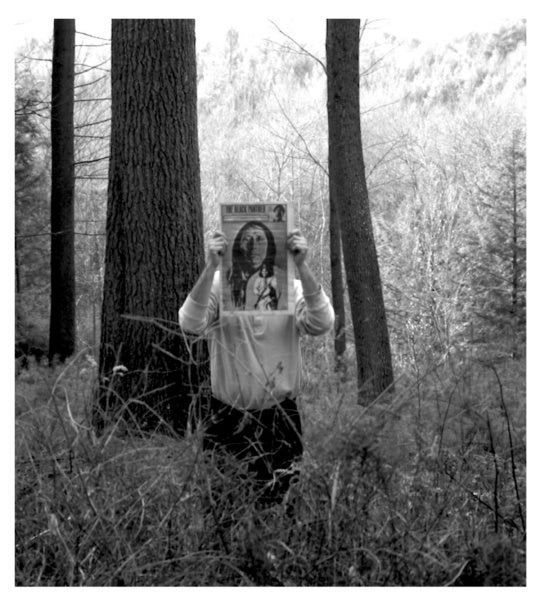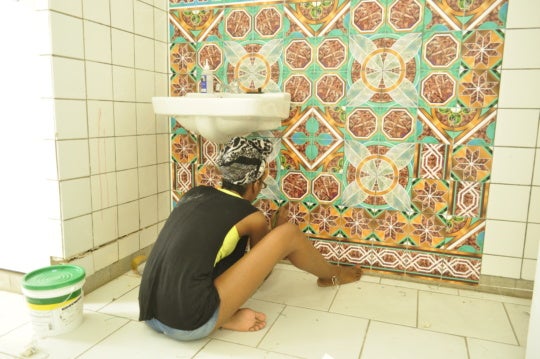
With “Inhuman,” his first solo show at Sandler Hudson Gallery, Atlanta-based artist William Downs expands upon the evocative visual language he previously developed in ink-wash works on paper, reimagining iconic figurative depictions from Western art history, such as Cézanne’s Bathers, in a muddled, dreamlike style. Created using a technique derived from traditional Japanese calligraphy, the array of works in “Inhuman” readily suggest their relationship to painting and the history of painting even as their deliberate grayscale palette—and the artist’s own assertions—characterize them as drawings. Beyond such distinctions, Downs’s central concern throughout “Inhuman” is with bodies: how they are imagined and desired, how they have been depicted in centuries past, and how they exist in relationship to the landscapes that contextualize them.
The objects that accompany Downs’s drawing Yoga Girls suggest the space of an artist’s studio more than that of a gallery: a messy shelf of materials, a small Cézanne reproduction one imagines being used for reference, a potted plant. With its title updated for the age of wellness and self-care, Yoga Girls has an obvious enough compositional relationship to The Bathers: nude, vaguely female figures arranged so that an inverted triangle of negative space forms between their bodies. Downs, however, pursues a different route to navigate between figuration and abstraction. Unlike Cézanne’s bathers, who almost appear to be a part of their surroundings, Downs’s yoga girls themselves create the landscape with their overlapping, fragmentary bodies. This difference indicates that Downs is depicting a psychological scene rather than abstracting a realistic one. Within the mind of an individual, as in Yoga Girls, the boundaries between figure and landscape blur and bleed.

Though he is in a certain sense addressing and revising canonical works of European art, Downs’s project should not be understood in the same sense as, for example, the work of Kehinde Wiley. Downs is not interested in anything nearly as definite as the sort of art historical correction Wiley pursues, always favoring inchoate images and associations over clarity. The female figure in the drawing Every rose has a thorn noticeably favors her counterpart in Leonardo’s Mona Lisa, but not enough to link the two as forcefully as Yoga Girls and The Bathers. (As a nude portrait, the figure in Every rose bears even more resemblance to the women in the Mona Vanna, two paintings with the same name by students and admirers of Leonardo offering topless variations on the Mona Lisa.) In addition to responding to that incomparably famous image of a woman, Downs also prominently includes components of his particular visual language, such as the tangle of thorns comprising the figure’s hair. The border framing Every rose contains shapes Downs created by using leaves as stencils for spray paint.

Leaves and thorns appear again in The bathers, bathing, another Cézanne revision taking the form of a large-scale wall drawing. As in Yoga Girls, a compositional relationship to the original is present, but the tone is darker, more sinister. The faces and bodies of these bathers are more fractured and distorted than those in Yoga Girls, giving a sense of frantic motion within the static image. Webs of dark thorns bind the depicted figures together, encircling their throats, waists, and ankles. While Downs’s figures remain ambiguous and his work resists easy or literal interpretation, it is difficult to resist viewing The bathers, bathing as a possible depiction of the psychological trauma of slavery. Generally, viewers should hesitate to automatically racialize the work of a black artist—a point suggested so slyly and subtly last year in Paul Stephen Benjamin’s exhibition “Pure Black” that it likely escaped some white viewers—but the imagery of chains and despair in The bathers, bathing requires that such historical and racial meaning at least be considered seriously.

Such close consideration is similarly warranted by the drawing Unarmed, one of the eleven smaller works on paper also included in “Inhuman.” While many of the other smaller drawings appear as incremental developments on the path to creating works like Yoga Girls and The bathers, bathing, Unarmed presents a fully formed, arresting image. With its face so distorted by repetition that it is difficult to count the number of intertwined eyes, noses, and lips depicted, a figure raises its hands, which are also shown in multiple, layered renderings. Clouds of spray paint marked by leaf stencils fill in the figure’s lower body and appear above its head between raised hands. With these hands punctured by stigmata, Unarmed could be viewed as Downs’s reconfiguration of a crucifixion scene, yet it also recalls depictions of Hindu divinities. Its one word title, however, is more familiar as an adjective usually followed by some variation on the phrase “black man shot by police.” The figure in Unarmed could be standing in for Christ or for Shiva or for Stephon Clark.
The psychological landscape depicted by Downs in “Inhuman” is murky and unclear, but this lack of specificity allows for its ambiguities to become more capacious. Though they owe some debt to art history, these works are also informed by contemporary life and the artist’s own idiosyncratic experiences of both. With “Inhuman,” Downs demonstrates that when we look at an image, what we see passes through multiple inextricable filters: history, headlines, and our own mysterious consciousness.
William Downs’s “Inhuman” is on view at Sandler Hudson Gallery through June 9. Downs will be in conversation with Zuckerman Museum curator Sarah Higgins at an artist’s talk at the gallery this Saturday, June 2 at 2 pm.
Logan Lockner is an Atlanta-based critic and a contributing editor for BURNAWAY. His first curatorial project, “Lauren Sanders: Interiors and Props” is on view at Georgia State’s Welch School Galleries through early September.




